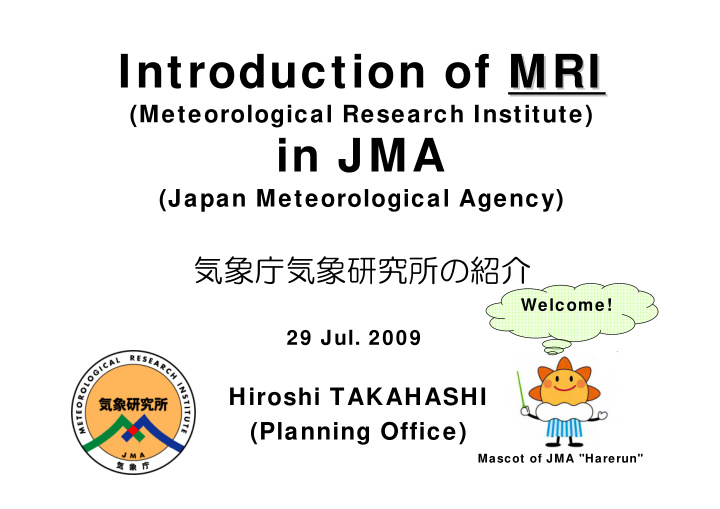



Introduction of MRI MRI (Meteorological Research Institute) in JMA (Japan Meteorological Agency) 気象庁気象研究所の紹介 Welcome! 29 Jul. 2009 Hiroshi TAKAHASHI (Planning Office) Mascot of JMA "Harerun"
MRI’s Organizational Position in JMA 気象庁のなかの気象研究所 About 5700 w orkers in JMA JMA MRI About 140 researchers and 33 officers in MRI
気象研究所の役割 MRI’s role WMO, IOC , etc. JMA Reports Research Programs Disaster mitigation Programs Technical Support etc. Contribution MRI (9 Res. Dep.) Forecast Research Climate Research Typhoon Research Physical Meteorology Research Atmospheric Environment and Applied Meteorology Research Meteorological Satellite and Seismology and Observation System Volcanology Research Research Oceanographic Research Geochemical Research
65yr History of MRI 気象研究所の歴史 Feb.1946 The Central Meteorological Observatory Research Division (CMORD) w as established. Apr.1947 The Meteorological Research Institute (MRI) w as reorganized from CMORD. Apr.1960 The Typhoon Research Department w as established. Jun. 1980 MRI moved to Tsukuba city from Tokyo. May 1987 The Climate Research Department and the Meteorological Satellite and Observation System Research Department w as established.
気象研究所の予算 Budget of MRI 30 million USD
Three Major Research Activities 主な研究内容 Monitoring, detecting, modeling, forecasting, predicting ・・・ • Severe Weather Severe Weather • Numerical studies of heavy rain using nonhydrostatic model (NHM/MRI) Studies of Detecting Meso-cyclone using Doppler w eather radar, tornado, etc. • Climate Change Climate Change • Sensitivity and projection studies of global w arming using a w ith GCM Climate change projection around Japan • Earthquakes Earthquakes and Volcanoes and Volcanoes • Studies to improve accuracy of forecasting the Tokai earthquake Tsunami simulation
Severe Weather 1/3: Numerical studies of heavy rain using nonhydrostatic Numerical studies of heavy rain using nonhydrostatic model (NHM/MRI) model (NHM/MRI) Observation Simulation Analyzed precipitation by surface observation and radar. 3 hours precipitation (9am-12am, 13 Jul 2004) simulated w ith 1.5km mesh NHM/MRI.
Severe Weather 2/3: Forecast Experiment of Mynmar Mynmar cyclone Nargis cyclone Nargis Forecast Experiment of Numerically reproduced Nargis Area damaged by storm surge Low resolution High resolution Storm surge simulation by ocean model 8
Severe Weather 3/3: Studies of Detecting Meso- -cyclone using cyclone using Studies of Detecting Meso Doppler w eather radar Doppler w eather radar 100km 1 0 0 k m (m/s) (dBZ) PPI display of Doppler velocity PPI display of radar reflectivity (left) and Doppler field (elevation 0.1 degree) velocity (right) obtained from MRI Doppler radar at relative to storm motion 16:08 on 10 July, 2002. Meso-cyclone signature, inside obtained by MRI Doppler radar the solid rectangle, is detected in Doppler velocity field. at 16:08.
Climate 1/5: Global annual surface temperature change Global annual surface temperature change A1B (2090- -2099) 2099) – – Present (1979 Present (1979 - -1998) 1998) A1B (2090 Japan 10
Climate 2/5: ℃ ) Change of Extreme hot day (max >35 ℃ ) Change of Extreme hot day (max >35 Future (2075 - -2099) 2099) – – Present Present Future (2075 [day/yr] 11
Climate 3/5: Future Typhoon projection Future Typhoon projection Japan Early period of 21st C. End of 21st C. 30% decrease in the number (But, increase in the strength?) 12
Climate 4/5: Muximum w ind speed vs. center w ind speed vs. center Muximum pressure of Typhoon pressure of Typhoon present present Future Future projection projection Severe typhoon will increase! 13
Climate 5/5: Climate change projection around Japan Climate change projection around Japan Using the Coupled atmosphere-ocean Regional Climate Model (CRCM) developed by JMA's Meteorological Research Institute (MRI) Sea Level Surface air temperature in w inter Precipitation in w inter Projected 100-year linear trends (1981 - 2100) in annual sea levels Projections of changes in mean Projections of changes in around Japan calculated using the surface temperature in winter precipitation in winter NPOGCM for scenarios A1B (cm / (December - March) for (December - March) for the 100yr) scenarios A1B for the period scenarios A1B for the period 2081 - 2100 relative to the 2081 - 2100 relative to the [*] denotes the value is not statistically period 1981 - 2000 period 1981 - 2000 significant, and a value with [ ] denotes that the value is uncertain.
Research Facilities • Supercomputer system Supercomputer system • The MRI computing system has high calculation performance (ranked about 100 th in the world in 2009). This system is used for various researches. • Meteorological observation tow er Meteorological observation tow er • (213m height, under demolition w ork!) (213m height, under demolition w ork!) We are here!
Research Facilities • Large meteorological w ind tunnel Large meteorological w ind tunnel • The MRI Large Wind Tunnel is one of the largest boundary-layer wind tunnels in Japan, with a long test section and heating/cooling systems. Since the maximum wind speed is high, this wind tunnel is also available for other purposes, e.g., development of meteorological instruments. The measurement system includes a hot-wire anemometer, a laser Doppler anemometer, a sonic anemometer, and a cold-wire anemometer.
Research Facilities • Doppler w eather radar Doppler w eather radar • • Lidar Lidar • • Cold environmental simulator Cold environmental simulator • etc.
Recommend
More recommend